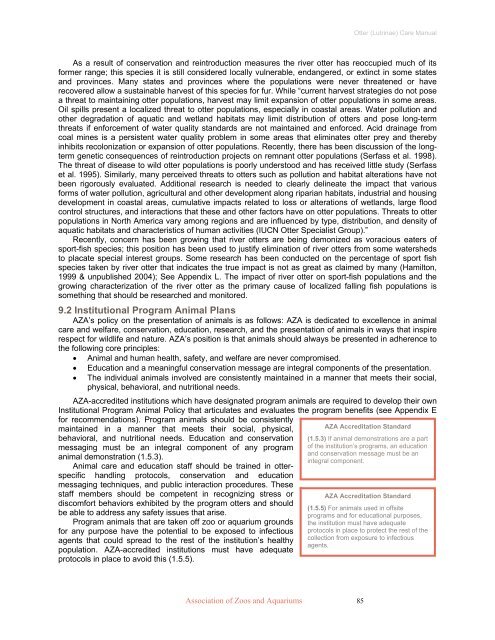Otter (Lutrinae) Care Manual - Association of Zoos and Aquariums
Otter (Lutrinae) Care Manual - Association of Zoos and Aquariums
Otter (Lutrinae) Care Manual - Association of Zoos and Aquariums
You also want an ePaper? Increase the reach of your titles
YUMPU automatically turns print PDFs into web optimized ePapers that Google loves.
<strong>Association</strong> <strong>of</strong> <strong>Zoos</strong> <strong>and</strong> <strong>Aquariums</strong> 85<br />
<strong>Otter</strong> (<strong>Lutrinae</strong>) <strong>Care</strong> <strong>Manual</strong><br />
As a result <strong>of</strong> conservation <strong>and</strong> reintroduction measures the river otter has reoccupied much <strong>of</strong> its<br />
former range; this species it is still considered locally vulnerable, endangered, or extinct in some states<br />
<strong>and</strong> provinces. Many states <strong>and</strong> provinces where the populations were never threatened or have<br />
recovered allow a sustainable harvest <strong>of</strong> this species for fur. While “current harvest strategies do not pose<br />
a threat to maintaining otter populations, harvest may limit expansion <strong>of</strong> otter populations in some areas.<br />
Oil spills present a localized threat to otter populations, especially in coastal areas. Water pollution <strong>and</strong><br />
other degradation <strong>of</strong> aquatic <strong>and</strong> wetl<strong>and</strong> habitats may limit distribution <strong>of</strong> otters <strong>and</strong> pose long-term<br />
threats if enforcement <strong>of</strong> water quality st<strong>and</strong>ards are not maintained <strong>and</strong> enforced. Acid drainage from<br />
coal mines is a persistent water quality problem in some areas that eliminates otter prey <strong>and</strong> thereby<br />
inhibits recolonization or expansion <strong>of</strong> otter populations. Recently, there has been discussion <strong>of</strong> the longterm<br />
genetic consequences <strong>of</strong> reintroduction projects on remnant otter populations (Serfass et al. 1998).<br />
The threat <strong>of</strong> disease to wild otter populations is poorly understood <strong>and</strong> has received little study (Serfass<br />
et al. 1995). Similarly, many perceived threats to otters such as pollution <strong>and</strong> habitat alterations have not<br />
been rigorously evaluated. Additional research is needed to clearly delineate the impact that various<br />
forms <strong>of</strong> water pollution, agricultural <strong>and</strong> other development along riparian habitats, industrial <strong>and</strong> housing<br />
development in coastal areas, cumulative impacts related to loss or alterations <strong>of</strong> wetl<strong>and</strong>s, large flood<br />
control structures, <strong>and</strong> interactions that these <strong>and</strong> other factors have on otter populations. Threats to otter<br />
populations in North America vary among regions <strong>and</strong> are influenced by type, distribution, <strong>and</strong> density <strong>of</strong><br />
aquatic habitats <strong>and</strong> characteristics <strong>of</strong> human activities (IUCN <strong>Otter</strong> Specialist Group).”<br />
Recently, concern has been growing that river otters are being demonized as voracious eaters <strong>of</strong><br />
sport-fish species; this position has been used to justify elimination <strong>of</strong> river otters from some watersheds<br />
to placate special interest groups. Some research has been conducted on the percentage <strong>of</strong> sport fish<br />
species taken by river otter that indicates the true impact is not as great as claimed by many (Hamilton,<br />
1999 & unpublished 2004); See Appendix L. The impact <strong>of</strong> river otter on sport-fish populations <strong>and</strong> the<br />
growing characterization <strong>of</strong> the river otter as the primary cause <strong>of</strong> localized falling fish populations is<br />
something that should be researched <strong>and</strong> monitored.<br />
9.2 Institutional Program Animal Plans<br />
AZA’s policy on the presentation <strong>of</strong> animals is as follows: AZA is dedicated to excellence in animal<br />
care <strong>and</strong> welfare, conservation, education, research, <strong>and</strong> the presentation <strong>of</strong> animals in ways that inspire<br />
respect for wildlife <strong>and</strong> nature. AZA’s position is that animals should always be presented in adherence to<br />
the following core principles:<br />
• Animal <strong>and</strong> human health, safety, <strong>and</strong> welfare are never compromised.<br />
• Education <strong>and</strong> a meaningful conservation message are integral components <strong>of</strong> the presentation.<br />
• The individual animals involved are consistently maintained in a manner that meets their social,<br />
physical, behavioral, <strong>and</strong> nutritional needs.<br />
AZA-accredited institutions which have designated program animals are required to develop their own<br />
Institutional Program Animal Policy that articulates <strong>and</strong> evaluates the program benefits (see Appendix E<br />
for recommendations). Program animals should be consistently<br />
maintained in a manner that meets their social, physical,<br />
behavioral, <strong>and</strong> nutritional needs. Education <strong>and</strong> conservation<br />
messaging must be an integral component <strong>of</strong> any program<br />
animal demonstration (1.5.3).<br />
Animal care <strong>and</strong> education staff should be trained in otterspecific<br />
h<strong>and</strong>ling protocols, conservation <strong>and</strong> education<br />
messaging techniques, <strong>and</strong> public interaction procedures. These<br />
staff members should be competent in recognizing stress or<br />
discomfort behaviors exhibited by the program otters <strong>and</strong> should<br />
be able to address any safety issues that arise.<br />
Program animals that are taken <strong>of</strong>f zoo or aquarium grounds<br />
for any purpose have the potential to be exposed to infectious<br />
agents that could spread to the rest <strong>of</strong> the institution’s healthy<br />
population. AZA-accredited institutions must have adequate<br />
protocols in place to avoid this (1.5.5).<br />
AZA Accreditation St<strong>and</strong>ard<br />
(1.5.3) If animal demonstrations are a part<br />
<strong>of</strong> the institution’s programs, an education<br />
<strong>and</strong> conservation message must be an<br />
integral component.<br />
AZA Accreditation St<strong>and</strong>ard<br />
(1.5.5) For animals used in <strong>of</strong>fsite<br />
programs <strong>and</strong> for educational purposes,<br />
the institution must have adequate<br />
protocols in place to protect the rest <strong>of</strong> the<br />
collection from exposure to infectious<br />
agents.









